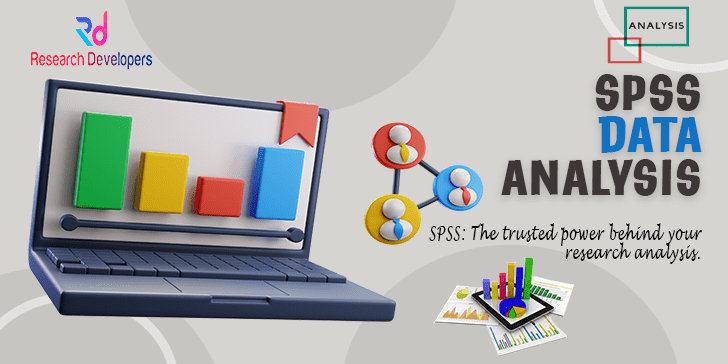Spss Data Analysis
Where research begins: Expert guidance on topic selection.

Spss Data Analysis
Nowadays, the majority of social science researchers use quantitative data analysis in their research. There is a sizable selection of software programs available to perform this kind of analysis. Among the few general-purpose statistical analysis software packages on the market are R, PSPP, Stata, SAS, SPlus, JASP, and BMDP. A portion of these are available for public use, while the remainder are licensed for commercial use. Quantitative data analysis is also possible with Microsoft Excel, a popular spreadsheet program, thanks to an add-on module. These options are accessible substitutes for SPSS, despite the fact that they are not very user-friendly. SPSS is used by the majority of educational and non-educational institutions because of its user-friendly characteristics.
For quantitative data analysis, SPSS isn’t always the best tool available, despite its many advantages over competing tools. There are certain software programmes that have far more functionality than SPSS. SPSS is compatible with Windows, Mac OS, and Linux, the three main computer operating systems.
The fact that SPSS was created with non-technical users especially people working in the social sciences in mind is its most significant feature. Therefore, no previous expertise of programming languages is required in order to use the application. As a consequence, the software is not only intuitive to use but also readily adaptable to many forms of quantitative analysis. Its ability to manage data is another amazing feature that makes it stand out from the competition for researchers across the globe.
The ease with which the application can generate reports is impressive. One must prioritize this program’s comprehensiveness and flexibility in quantitative data analysis over all other options. SPSS is used in social science research because it allows for collaboration, authorization, and the deployment of survey data for strategic data mining for statistical analysis.
Understanding the fundamentals of using SPSS makes it simpler for researchers to utilize the program to analyze quantitative data effectively. As a result, it supports the researcher through any challenges encountered along the way. Using SPSS, you must first define a set of variables. Then, you must generate cases by entering appropriate data into these variables.
The SPSS datasheet has four main categories of variables. The given variables include independent, dependent, intervening, and moderator variables. A cause is, to put it simply, an independent variable. Its value in a study is unaffected by any other variables. On the other hand, an effect that is dependent on changes in the independent variable is known as a dependent variable. An intervening variable, also known as a mediating variable, is a hypothetical variable that is typically employed in research to elucidate the causal relationships between other variables. Finally, the variable that has the ability to change the relationship between independent and dependent variables is known as the moderating variable. Determining the variables is crucial.
Tables and graphs can be created with SPSS, a Windows-based application for data analysis as well as entry. Large data sets can be handled by SPSS, which can also be used to do each of the analyses discussed in the text and furthermore. Because SPSS is utilised extensively in both the business as well as social sciences, becoming familiar with it now will benefit you in the long run. SPSS is frequently updated.
Features:
Basic statistical operations, such as descriptive statistics to ascertain frequency, variance, etc., can be carried out using the Statistical Package for the Social Sciences. Additionally, there are functions for group identification predictions, numerical outcome forecasts, bivariate statistics, and analytic statistics for more sophisticated features. You can reorganise your data in SPSS to streamline the data processing process. Renaming data and editing groups many times is possible if necessary. Actually, there are just two categories of data: strings (text) and numbers. The data is then processed successively by the Statistical Package for the Social Sciences. Following treatment, you can export your results—that is, the tables and graphs—into other applications, including Microsoft Word. The user’s level of expertise determines how something is interpreted. Furthermore, files created with the for the Social Sciences, Statistical Package will be preserved in spo.
System utilized
Hard disk space: 512mb
Operating Systems: Windows 7, Windows 8, Windows 8.1, Linux
Statistics Application:
The study of gathering information, analysing it, interpreting it, organisation, and presentation is known as statistics. It is customary to start with a statistical model process or statistical population to be researched when applying statistics to, say, a societal, industrial, or scientific problem. “All atom constituting a crystal” or “every individual residing in a country” are two examples of diverse populations. All facets of data are covered by statistics, such as the organisation of data gathering in terms of survey and experiment design.
In situations where census data collection is not feasible, statisticians employ targeted experiment techniques as well as survey samples to gather data. Deductions and conclusions drawn from the sample can be securely applied to the entire population thanks to representative sampling. In a research study, the system being studied is measured, it is then adjusted, and further measurements are taken using the same protocol to see if the manipulation has affected the measurement values. An empirical investigation, on the other hand, does not entail manipulation through experiments.
IBM SPSS Statistics:
The whole analytical process is covered by the integrated family of IBM SPSS Statistics tools, which includes planning, collecting information, analysing it, disclosure, and implementation. You can select from over a dozen fully integrated modules to get the specific features you require to boost sales, beat rivals, carry out research, and make wiser decisions.
SPSS Statistics:
SPSS Statistics is a software tool used for statistical analysis. Long-produced by SPSS Inc., IBM acquired it in 2009. IBM SPSS Statistics is the official name of the most recent version (2015). The same family of products includes companion solutions for text analytics, data mining (IBM SPSS Modeller), survey writing and deployment (IBM SPSS Data Collection), and collaboration and installation (automated and batch scoring solutions).
Even while the programme is currently widely utilised in a variety of other fields, such as marketing and the health sciences, its initial name, Statistical Package for the Social Sciences (SPSS), reflected the software’s target market.
A popular tool for statistical analysis in social science is SPSS. In addition, market education researchers, health research centres, research firms, government agencies, data miners, government agencies, and others utilize it. Some have called the first SPSS manual one of “sociology’s most influential books” because it made statistical analysis accessible to regular scholars.The base software includes statistical analysis as well as data administration (derived data creation, file reshaping, case selection), and data documentation (a meta-data dictionary was kept in the data files).
SPSS modeler:
IBM SPSS Modeller is a text analytics and data mining software programme. It is employed in other analytical activities such as the construction of predictive models. Users can employ data mining as well as statistical techniques with its visual interface without needing to know programming.
Integral Solutions Limited, the company that created IBM SPSS Modeller, initially called it Clementine. For some time following SPSS’s purchase of the product, this name was used. Later on, SPSS rebranded itself as SPSS Clementine, and subsequently as PASW Modeller. To its current name, the product was given the same name, IBM SPSS Modeller, after IBM acquired SPSS in 2009.
Application:
These and other industries have utilised SPSS Modeller:
Entertainment: e.g., predicting movie box office receipts
Telecommunications
Education
Law enforcement and border security
Forecasting demand or sales
Healthcare quality improvement
Manufacturing quality improvement
Risk management
Optimizing insurance claims
Fraud detection and prevention
Customer analytics and Customer relationship management (CRM)
How to use SPSS:
A graphical user interface is included in the sophisticated, proprietary, commercial statistical analysis software suite called SPSS. It is one of the most popular software packages for statistical data analysis among academics, particularly in the social sciences.
Around the world, students enrolled in social science university degree programmes are frequently, but not always, taught how to use SPSS.
Several limitations, however, exist with use of SPSS, including:
Although the complete version costs over $1000 and requires annual licence fees, there is a trail version available.
Student versions have limitations on the number of instances, variables, and complex statistical functions, making them not entirely useful.
Thankfully, the free alternative, PSPP, contains an infinite number of cases and variables and can be obtained for little to no cost. However, several sophisticated statistics—most notably GLM—are not currently supported. In many university departments of social science, proficiency with SPSS/PSPP is practically a need.
Utility for chi-square analysis, principal components analysis, cluster analysis, factor analysis, tests and more. As of 2014, a few extremely sophisticated statistical tests have not been used.
At the user’s choice, statistical graphics and output are available in HTML, SVG, PostScript, PDF, or ASCII formats. One can create a variety of statistics graphs, for instance np-charts, pie-charts scree plots and histograms.
Other Services
- PHD & POST DOC Admission counselling
- Topic Section
- Review Paper Writing
- Systematic Literature Review (SLR)
- Research Paper Writing
- Synopsis Writing/Pre thesis writing
- Thesis Writing
- Data Analysis
- Questionnaire Preparation
- Developing Research Framework
- Methodology Development
- MATLAB Implementation
- Matlab Simulation
- Python Implementation
- Machine Learning Implementation
- Deep Learning Implementation
- VHDL Implementation
- Hadoop
- NS2 Implementation
- NS3 Implementation
- ArcGis Mapping & Analysis
- Spss Data Analysis
- Stata Data Analysis
- Amos Analysis
- R Programming
- E-Views Data Analysis
- Minitab Data Analysis
- Software Testing
- Ansys Implementation

